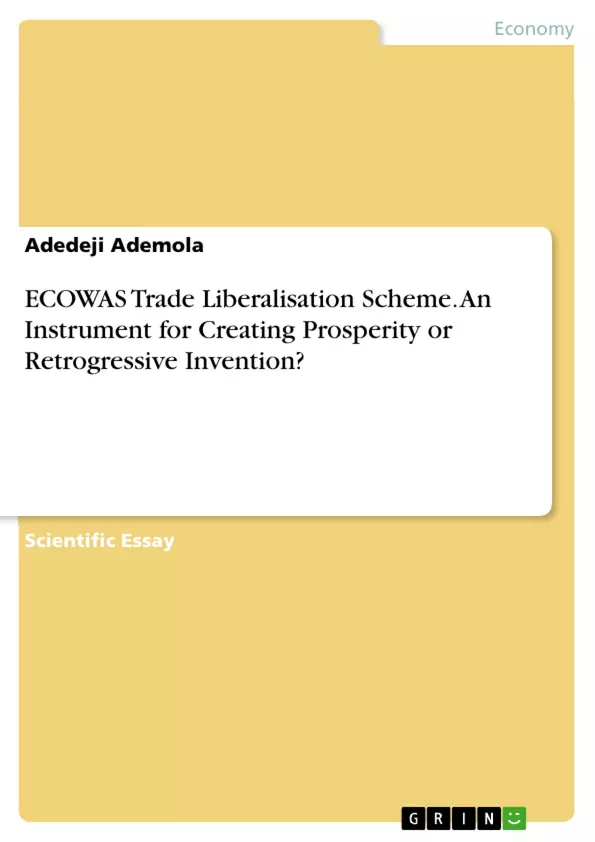This paper focuses on ECOWAS Trade Liberalisation Scheme and its attendant challenges for regional integration in West Africa. The paper draws on academic and policy literatures, empirical evidence and participant observation as well as elite interviews. It submitted that the ETLS launched to facilitate the establishment of a Common External Tariff and the creation of a Free Trade Area had not achieved its intended mandate or objective. Several obstacles still impeded growth of subregional bilateral ties and intra-trade in West Africa and realigning the protocols to suit the economy of member states is therefore inevitable.
Although established to promote intra-trade in West Africa and facilitate accelerated economic progress among member states, ECOWAS Trade Liberalisation Scheme (ETLS) is yet to be fully realised. Scholars have argued that ETLS has recorded significant economic feats for member states in the subregion; but some contended that ETLS performance has been discouraging and this became noticeable with the call by some legislators in Nigeria (the biggest economy in the region) for a ‘technical exit’ of Nigeria from the regional body. More than two decades after the launching of the ETLS, ECOWAS member states still seem to choose products and investments from outside West Africa rather than trade, manufacture and add value within and when they
trade with themselves, economic sabotage, sharp economic practices and abuse of ETLS rules of Origin seems to be the norm, hurting member’s economy rather than building it.
Table of Contents
- Abstract
- Introduction
- Problem Statement
- Objectives of the Study
- Literature Review
- Methodology
- ECOWAS Trade Liberalisation Scheme and Its Challenges
- ECOWAS and Trade Liberalisation
- Obstacles to the Implementation of ETLS
- Role of Non-Tariff Barriers (NTB)
- Political Instability
- Corruption
- Recommendations
- Conclusion
Objectives and Key Themes
This paper aims to analyze the effectiveness of the ECOWAS Trade Liberalisation Scheme (ETLS) in promoting regional integration and fostering economic growth in West Africa. The study explores the challenges hindering the scheme's full implementation, examining the impact of non-tariff barriers, political instability, and corruption on regional trade.
- Effectiveness of the ECOWAS Trade Liberalisation Scheme
- Obstacles to the implementation of ETLS
- Impact of non-tariff barriers on regional trade
- Role of political instability in hindering regional integration
- Impact of corruption on economic development in West Africa
Chapter Summaries
- Abstract: Provides a concise overview of the research topic, highlighting the challenges faced by the ECOWAS Trade Liberalisation Scheme and its impact on regional integration in West Africa.
- Introduction: Introduces the concept of regional integration in Africa and its importance for economic growth. Discusses the historical context of ECOWAS and its efforts to improve trade relations among member states.
- Problem Statement: Highlights the challenges faced by the ETLS in achieving its objective of free movement of goods and promoting economic integration. Examines the reasons for the low level of intra-regional trade in West Africa.
- Objectives of the Study: Outlines the specific research objectives, which include appraising the components of the ECOWAS Trade Liberalisation Scheme, identifying obstacles to its implementation, and analyzing the role of non-tariff barriers and political instability.
- Literature Review: Reviews existing literature on regional integration, trade liberalization, and the specific challenges faced by ECOWAS in promoting intra-regional trade.
- Methodology: Describes the research methodology used in the study, including data collection methods, sources of information, and analytical framework.
- ECOWAS Trade Liberalisation Scheme and Its Challenges: Provides a detailed overview of the ETLS, its goals, and the challenges it faces in promoting regional integration.
- ECOWAS and Trade Liberalisation: Explores the historical development of ECOWAS's trade liberalization policies and the factors influencing its effectiveness.
- Obstacles to the Implementation of ETLS: Examines the key obstacles hindering the implementation of the ETLS, including non-tariff barriers, political instability, and corruption.
- Role of Non-Tariff Barriers (NTB): Analyzes the impact of non-tariff barriers on regional trade, highlighting how they create barriers to market access and limit intra-regional trade.
- Political Instability: Discusses the role of political instability in hindering regional integration, examining how conflicts and security issues impede trade and economic development.
- Corruption: Explores the impact of corruption on economic development in West Africa, analyzing how it undermines trade liberalization efforts and hinders the effectiveness of the ETLS.
- Recommendations: Provides recommendations for overcoming the challenges facing the ETLS and promoting regional integration in West Africa.
Keywords
This study focuses on the challenges and potential solutions to facilitate economic integration in West Africa through the analysis of the ECOWAS Trade Liberalisation Scheme (ETLS). Key topics examined include regional trade, non-tariff barriers, political instability, corruption, and their impact on economic growth and development. The study aims to contribute to the ongoing debate surrounding the effectiveness of regional integration initiatives in Africa.
- Quote paper
- Adedeji Ademola (Author), 2014, ECOWAS Trade Liberalisation Scheme. An Instrument for Creating Prosperity or Retrogressive Invention?, Munich, GRIN Verlag, https://www.grin.com/document/1033891



